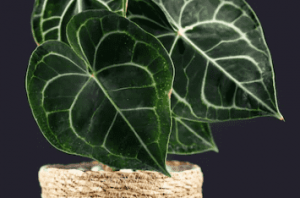Anthurium clarinervium is an amazing plant species of mother nature. It is native to the tropical forests of Southern Mexico. It belongs to the family Araceae and is an epiphyte in nature. These are the cousins of the popular philodendrons and are low-maintenance plants. The genus Anthurium is native to the USA and has more than 800 species.
The Clarinervium plant is pretty enough to be an important species for the collection of indoor plants. The unique and prominent velvety green leaves are the reason for their beauty and popularity.
It is not commonly found in the USA but people try to get it through overseas shipping procedures. In this article, we will discuss some important features of the Anthurium clarinervium along with its care and propagation.
Anthurium Clarinervium Common Names

- It is commonly called ‘white-veined Clarinervium’.
- It is called ‘Queen Anthurium’ among the species of the Anthurium genus.
- Due to its stiff velvety leaves, it is called ‘Velvet Cardboard Anthurium’.
- Anthurium clarinervium matuda is also an accepted name.
Features of the Anthurium Clarinervium Plant

Some of the important features of the plant are mentioned below:
Height:
The height of the plant varies according to the species and the environment. The average plant is 16 to 25 inches in height.
Spread:
The spread of an average plant is around 20 to 40 inches although just like the height, it also varies according to the species and growth conditions.
Leaves:
The plant has unique, big, bright, and attractive leaves that are loud and exhibit their nativity to the jungles. The leaves are heart-shaped with dark green color and light green shade on the underside. Leaves exhibit prominent white veins making a beautiful pattern throughout the leaf surface. The thick velvety leaves are evergreen in nature and get about 6 to 12 inches long.
Flower:
The plants of the Anthurium family have considerably beautiful flowers with a typical shine and long life. The Anthurium Clarinervium flower is not as attractive as the flowers of other members. These are seasonal, small in size, and pale or Spadix green in color with shades of violet. The bloom size is around 3 to 4 inches.
Fruit:
The fruit of the plant is prominent and on maturity, it turns orange in color. It is Epiphytic and around I to 3 feet in length.
Toxicity:
The plant contains crystals of Calcium Oxalate in all of its parts. It is toxic and creates ulceration in the throat and esophagus along with other health problems on being ingested. Babies and pets are strictly advised to be kept away from playing around with the Anthurium clarinervium plant.
Deer and Rabbit Resistance:
This plant is resistant to common grazers like deer and rabbits.
Anthurium Clarinervium Care

You need to smartly observe the plant and see its condition. This observation will help you understand the requirements of the Clarinervium and you can create and rectify your routine accordingly. Important points are mentioned below:
Soil Requirement:
The soil requirement of this plant is very specific. It should be a combination of water drainage and slight water holding. For indoor cultivation, a mixture of potting soil and orchid mix soil in equal ratios is suggested. Potting soil and perlite also work well.
A breathable mixture of potting soil, moss, mulch, gravel, charcoal, perlite, and sphagnum moss is also recommended. Make sure that along with moisture, you keep the soil dry in intervals as these plants don’t prefer moist soil in continuation.
Light Requirement:
Growing Season
The plants of the Anthurium family require medium to bright levels of indirect light. They are sensitive enough to get burnt due to direct sun exposure for a longer duration.
Dormancy Season
However, in their dormant stage in the winter season, these plants can easily survive in lesser light exposure.
Water Requirement:
The water requirement of the plant usually depends upon the weather and the environment.
Growing Season
Water requirements in March to September are higher because the weather is hot and the plant is in its growing season. You need to check that the upper layer of the soil should be dry while the lower layer should be 80% dry before you water the plant again.
To check this, just dig a finger into the soil and if it is wet, it is an indication to wait for a day before watering. The temperature and humidity levels inside the house also affect the water requirement of the plant.
Dormancy Season
In dormancy, the water requirement reduces to twice or thrice a month.
Note:
Always avoid overwatering the plant as it leads to different issues of the plant.
Anthurium Clarinervium Temperature Requirement:
The ideal temperature for the Clarinervium plant is between 65 to 70 degrees Fahrenheit.
In winter, a temperature below 55 degrees can even freeze and kill the plant. So you need to keep the plant at a warm temperature in the cold season.
Good air circulation is a healthy effect. Direct exposure to strong winds, heaters, and air conditioners is not healthy for the plant as it can destroy the leaves. Similarly keeping the plant near a window in frosting season is also an unhealthy effect on the plant.
Humidity Requirement:
The Anthurium clarinervium are moisture-loving plants and suffer in dry environments.
If you find the environment to be dry or the plant is giving signals of inadequate moisture level by turning its edges brown you can increase it by following any of the undermentioned methods;
- Misting the leaves with a spray bottle.
- Adding a humidifier in the room.
- Putting a pebble and water-filled tray under the pot of the plant. This is a common method to increase the humidity levels for indoor plants including the Anthurium Clarinervium.
Note:
These are moisture-loving but avoid keeping them ‘soggy’ as it leads to different issues in the health of the Clarinervium plant.
Pot Requirement:
In indoor cultivation, the minimum ideal size of the pot is 1 gallon with good soil drainage.
Fertilizer Requirement:
Growing Season
In the growing season, the plant needs a suitable formula once a month or every 6 weeks.
Dormancy Season
In winters, the plant does not need much fertilizer. A low quantity of fertilizer once in three months would be enough.
Growth Zone:
The Hardiness growth zones are 9a to 11.
Anthurium Clarinervium Propagation

The cultivation of the plant is usually done by the division of the plant and its roots. The ideal time for the cultivation of the Clarinervium is in the spring season.
The whole process has to be done very gently to avoid the plant from being destroyed.
- Take a shovel and take the plant out along with the roots.
- Now by looking at the plant, observe the roots which can be divided.
- Now pull the plant and divide it into pieces.
- Do the division by keeping healthy roots available on both of the plants. At least one or a pair of leaves should be present on the baby plant.
- Now plant the mother plant back or in the new pot if you want to repot.
- The baby plant should be potted in moist soil with the specific soil for Clarinervium which is the orchid mix. New shoots will start forming in three to four weeks being the sign of successful propagation of the Anthurium clarinervium .
Baby Clarinervium needs intense indirect light and regular watering for proper growth. Inadequate light may lead to issues like droopy or yellowing of leaves or the plant may fail to make its roots stronger in the soil. Overwatering and direct sun exposure may lead to root rot or burning of the plant respectively. So these should be avoided.
Common Problems With Anthurium Clarinervium
The increasing fondness with high levels of humidity makes it a hot spot for different pests. The mealybugs are one of the most dominant pests infecting the anthurium clarinervium. These bugs look like cottony substances and generate numerous problems for the plant by stealing the plant’s nutrients and water.
The problems may include leaves yellowing, droopy leaves, and stunned growth. In case of long infections, the plant may die. The second problematic pest is spider mites and this influences the plant negatively by preventing its photosynthesis. The brown scale insect is another common pest that is harmful to the plant’s growth.
Related Posts:
Frequently Asked Questions
Does Anthurium Clarinervium produce flowers?
Yes, this plant produces long cylindrical flowers that are attached to white leaves. And these flowers bloom during the growing season. Interestingly, the flowers change their color as the growing season ends and even bend, however, it’s natural and you do not need to worry about it.
Can I grow this plant in an indoor environment?
Yes, this plant can be grown easily within the indoor environment if the right conditions are provided to it. The adequate growth conditions include good humidity levels, artificial lighting, and adequate fertilizer.
How often Anthurium should be watered?
The plant must be watered according to its needs. You must be careful while watering it and avoid neither over-watering nor under-watering. You should water it once a week especially in case if the upper layer of soil dries.
Is Anthurium poisonous?
It is poisonous to both pets and humans; therefore, you need to be cautious while handling it.
Can I plant other plants along with Anthurium?
No, this plant possesses delicate roots, therefore, it cannot be planted with other plants. You must also check the weed growth near this plant as these weeds are also harmful to its growth.
Conclusion
Anthurium clarinervium are unique aroids popular for their big, beautiful, green velvety leaves with prominent white vein patterns on the leaf surface. The evergreen foliage is toxic so babies and pets should not be allowed to play around it. These are easy to keep and are beautiful enough to give an attractive look to any corner of your house.


Comments are closed.